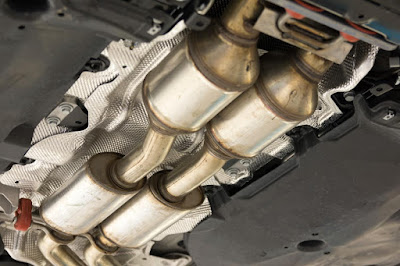We've said it time and time again, cars are complicated. They're made up of massive systems that all have to work perfectly to achieve the simple task of motion. While we know explaining the inner workings of a car is like diving down an ever complicated rabbit hole, understanding how the machine you depend on works can only amount to good.
One auto part you may have heard of before (likely in a news headline relating a Prius and theft), the catalytic converter, is one that's seemingly complicated, but knowledge of can help you better understand the science behind emission reduction. Follow along with us at Toyota of Orlando to learn more about this essential auto part!
What Exactly is a Cat Converter?
The catalytic converter, or cat for short, is an integral auto part that helps your ride reduce its natural creation of emissions. Emissions, like carbon monoxide, carbon dioxide, and other greenhouse gasses are released by vehicles that use internal combustion engines (ICEs). Before 1975, vehicles didn't use this part as it did not exist and emitted an uncontrollable amount of smog and harmful gasses. To conform to more necessary and strict emission restrictions at the time. The catalytic converter was then created.
Essentially, a catalytic converter acts as a mitigator of Orlando Toyota vehicle emissions by oxidizing and removing certain pollutants from exhaust smog. In most cases, cats oxygenate smog (which is made up mainly of oxygen, carbon monoxide, and various hydrocarbons). The runoff substances creating are carbon dioxide and water.
Why Use This Auto Part?
Cats are essential when it comes to reducing harmful emissions from your Orlando Toyota car's tailpipe. Granted, carbon dioxide is still a greenhouse gas in excess, it's less harmful than its less oxygen rich gaseous counterpart. The catalytic converter renders carbon monoxide (lethal if inhaled in large amounts) far less harmful and emits water as the other substrate. How is this accomplished, you may wonder? Find out here.
Cats come in various types, mainly 2 and 3-way connections to keep things simple. 2-way Orlando Toyota cats perform the standard operation of oxidizing carbon monoxide into carbon dioxide. This type of auto part oxidized several hydrocarbons as well, though not as effectively as some of its counterpart models. You can most often find this type of diesel fueled vehicles.
The alternative cat design is the 3-way. This type of connection more effectively controls the emission of nitric oxide . You can often find this type of cat model on Orlando Toyota cars that use ICEs.
There Are Always Drawbacks
Like anything, cats don't come without their fair share of drawbacks and criticisms. It's true that a vehicle performs best when there's a free flow of exhaust out the tailpipe and the cat converter acts as a form of middleman to remove harmful substances from the smog. This is essential for environmental betterment, but it does put a damper on overall horsepower and performance.
Cat converters, being a filter for your exhaust, can get clogged if you use fuel that's not specific for your engine. They're also prone to theft because they often contain precious metals. If you're an Orlando Toyota Prius driver, you've been warned.
Still have questions about cat converters and other auto parts? Visit Toyota of Orlando today at 3575 Vineland Road.


No comments:
Post a Comment
Note: Only a member of this blog may post a comment.